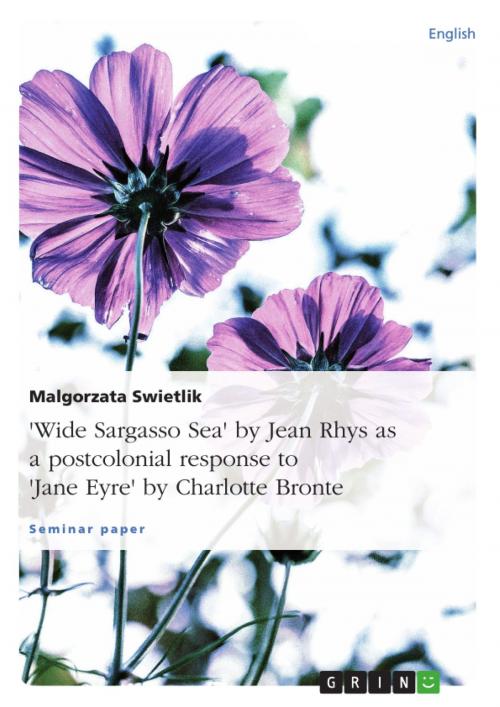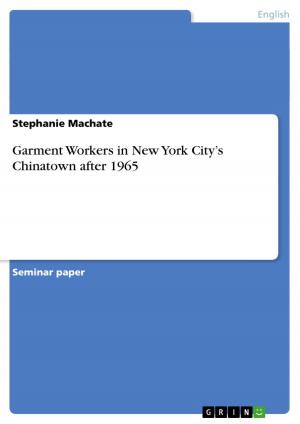'Wide Sargasso Sea' by Jean Rhys as a postcolonial response to 'Jane Eyre' by Charlotte Bronte
Fiction & Literature, Literary Theory & Criticism, British| Author: | Malgorzata Swietlik | ISBN: | 9783640896264 |
| Publisher: | GRIN Publishing | Publication: | April 18, 2011 |
| Imprint: | GRIN Publishing | Language: | English |
| Author: | Malgorzata Swietlik |
| ISBN: | 9783640896264 |
| Publisher: | GRIN Publishing |
| Publication: | April 18, 2011 |
| Imprint: | GRIN Publishing |
| Language: | English |
Seminar paper from the year 2008 in the subject English Language and Literature Studies - Literature, grade: 2,00, University of Koblenz-Landau (Anglistik), course: Colonial and Postcolonial Literatures, language: English, abstract: Wide Sargasso Sea is one of the best-known literary postcolonial replies to the writing of Charlotte Bronte and a brilliant deconstruction of what is known as the author's 'worlding' in Jane Eyre. The novel written by Jean Rhys tells the story of Jane Eyre's protagonist, Edward Rochester. The plot takes place in West Indies where Rochester met his first wife, Bertha Antoinette Mason. Wide Sargasso Sea influences the common reading and understanding of the matrix novel, as it rewrites crucial parts of Jane Eyre. The heroine in Jean Rhys's Wide Sargasso Sea, Antoinette Cosway, is created out of demonic and bestialic Bertha Mason from Jane Eyre. Rhys's great achievement in her re-writing of the Bronte's text is her creation of a double to the madwoman from Jane Eyre. The heroine of Wide Sargasso Sea, the beautiful Antoinette Cosway, heiress of the post-emancipation fortune is created out of the demonc and bestialic Bertha Mason. The author transforms the first Mrs Rochester into an individual figure whose madness is caused by imperialistic and patriarchal oppression The vision of Bertha/Antoinette as an insane offspring from a family plagued by madness is no longer plausible to the reader. In this essay I would like to focus the factors which led to the madness of the protagonist. Although Bertha Mason and Jane Eyre seem to be enemies and contradictory characters in the Victorian novel, many critics find several similarities between the two heroines, their life and finally between Jane Eyre and Wide Sargasso Sea. Seeing Jane Eyre and Antoinette Cosway as sisters and doubles is very popular with some critics who dealt with the works of Charlotte Bronte and Jean Rhys. Nevertheless, I would like to focus in this essay on Gayatri Chakravorty Spivak's criticism on viewing and interpreting the two heroines. Gayatri Chakravorty Spivak in her essay 'Three Women's Texts and a Critique of Imperialism' values also Jean Rhys for telling the story of Bertha Mason through the Creole perspective, but she criticises the author for marginalising the native inhabitants of West Indies.
Seminar paper from the year 2008 in the subject English Language and Literature Studies - Literature, grade: 2,00, University of Koblenz-Landau (Anglistik), course: Colonial and Postcolonial Literatures, language: English, abstract: Wide Sargasso Sea is one of the best-known literary postcolonial replies to the writing of Charlotte Bronte and a brilliant deconstruction of what is known as the author's 'worlding' in Jane Eyre. The novel written by Jean Rhys tells the story of Jane Eyre's protagonist, Edward Rochester. The plot takes place in West Indies where Rochester met his first wife, Bertha Antoinette Mason. Wide Sargasso Sea influences the common reading and understanding of the matrix novel, as it rewrites crucial parts of Jane Eyre. The heroine in Jean Rhys's Wide Sargasso Sea, Antoinette Cosway, is created out of demonic and bestialic Bertha Mason from Jane Eyre. Rhys's great achievement in her re-writing of the Bronte's text is her creation of a double to the madwoman from Jane Eyre. The heroine of Wide Sargasso Sea, the beautiful Antoinette Cosway, heiress of the post-emancipation fortune is created out of the demonc and bestialic Bertha Mason. The author transforms the first Mrs Rochester into an individual figure whose madness is caused by imperialistic and patriarchal oppression The vision of Bertha/Antoinette as an insane offspring from a family plagued by madness is no longer plausible to the reader. In this essay I would like to focus the factors which led to the madness of the protagonist. Although Bertha Mason and Jane Eyre seem to be enemies and contradictory characters in the Victorian novel, many critics find several similarities between the two heroines, their life and finally between Jane Eyre and Wide Sargasso Sea. Seeing Jane Eyre and Antoinette Cosway as sisters and doubles is very popular with some critics who dealt with the works of Charlotte Bronte and Jean Rhys. Nevertheless, I would like to focus in this essay on Gayatri Chakravorty Spivak's criticism on viewing and interpreting the two heroines. Gayatri Chakravorty Spivak in her essay 'Three Women's Texts and a Critique of Imperialism' values also Jean Rhys for telling the story of Bertha Mason through the Creole perspective, but she criticises the author for marginalising the native inhabitants of West Indies.















